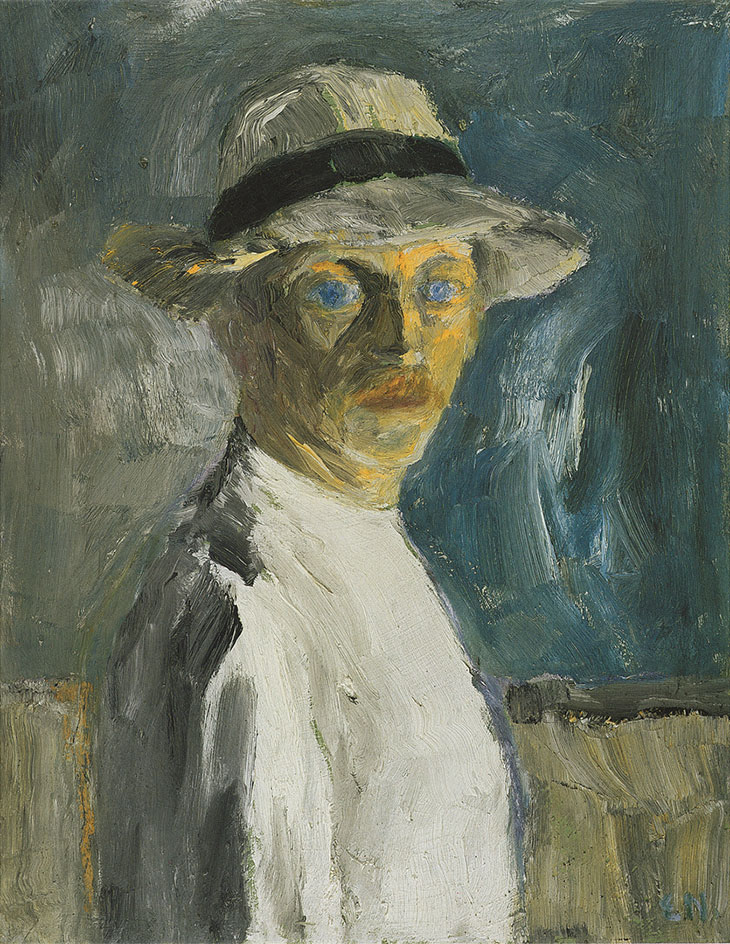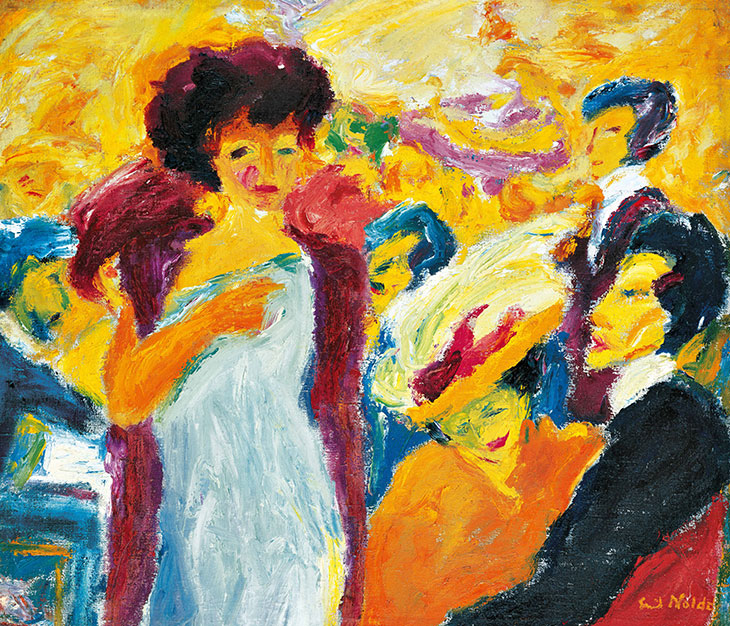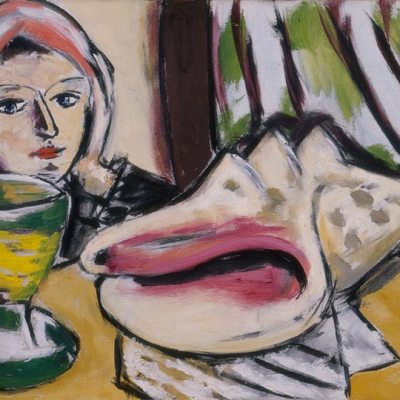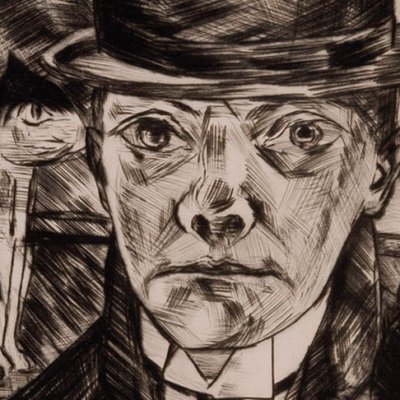At the outset of the Scottish National Gallery of Modern Art’s comprehensive survey of the work of German Expressionist Emil Nolde (previously at the National Gallery of Ireland), one picture is particularly striking. In his Self-portrait of 1917, Nolde’s white tunic and hat, yellow face and penetrating blue eyes are rendered with the same intense impasto as the ground and sky that vibrate around him. The artist is demanding that we see him as one with the elements.
Between this arresting overture and the dazzling conclusion of Large Poppies (Red, Red, Red) of 1942, in the final room, the visitor is taken on a voyage through the varied subjects that caught Nolde’s eye: from farmers working the land to decadent Berlin nightlife; from his own carefully cultivated gardens to turbulent seascapes and biblical scenes. Through them all, true to the exhibition’s title (‘Emil Nolde: Colour is Life’), it is the artist’s voracious appetite for colour that emerges as the main subject.
Selbstbild (Self-portrait) (1917), Emil Nolde. © Nolde Stiftung Seebüll

Nolde was at the forefront of a generation of German artists who eschewed saccharine Impressionism for a new, emotionally charged vocabulary. His debt to both his forebears and contemporaries is evident: the harrowing realism of Grünewald rubs shoulders with the heartfelt, early depictions of peasants by Nolde’s great hero Van Gogh; haunted, Ensor-like masks jostle with something like the gaiety of Toulouse-Lautrec. At various points in his career he flirted with the Expressionist group Die Brücke in Dresden, with the Berlin Secession, and Kandinsky’s Der Blaue Reiter. But he never fitted easily into one school.
Gesellschaft (Party). (1911), Emil Nolde. © Nolde Stiftung Seebüll

The artist was born Hans Emil Hansen into a farming family in the village of Nolde in Southern Jutland. Early experience of farming gave way to the demi-monde of Berlin’s cabaret scene where Nolde’s wife Ada Vilstrup worked as a dancer. Its louche characters and hubbub inspired vivid graphics, stage-lit in watercolour. The port of Hamburg also caught his eye. Hastily brushed, monotone suggestions of boats and waves are the most subtle works on show. For an artist best known for his attraction to the visceral, it is a revelation to find calm here in his approach to line and space.
Nolde’s religious paintings were often reviled in his own time, and it is not difficult to see why. The Bible in Nolde’s hands becomes a grotesque graphic novel painted by a devout but conflicted soul. Stories designed to take the viewer to a higher spiritual plane are brought by Nolde firmly down to earth. In his Ecstasy of 1929, temptation comes face to face with transcendence. Is the figure bearing a cross the nagging conscience of the brazen Mary Magdalene? Or is she defiantly exposing her flesh in rejection of possible redemption? Whatever the meaning, the real seduction here comes from the colour – rich mauves and oranges that surround the startling figures.
Ekstase (Ecstasy) (1929), Emil Nolde. © Nolde Stiftung Seebüll

Nolde’s depiction of Israelites in his Bible paintings would not have been out of place on a Nazi-propaganda pamphlet. He was a declared anti-Semite who aligned himself with the Nazis in the hope it would put him at the centre of the party’s cultural policy. His move backfired; more than 1,000 of his works were confiscated and some 33 of them – more than by any other artist – were selected for the Degenerate Art exhibition in Munich in 1937. During those turbulent years, when Nolde was barred from working as an artist, he produced an extensive series of ‘unpainted pictures’ – line and wash drawings of fantastical, Redon-esque figures. Some are enchanting. But the foreshortened Skater (c. 1930s–40s) resembles more an isolated, blindfolded victim, bound up in one of Francis Bacon’s bleak rooms.
Along with religion, the landscape exerted a fascination for Nolde. In paintings like Light Breaking Through (1950), the meteorological mood of northern Europe is captured with the full force of Nolde’s brush. Waves crash and churn; the oppression is tangible. It feels as though nature became Nolde’s metaphor for the turbulence of his time.
Großer Mohn (Rot, Rot, Rot) (Large Poppies [Red, Red, Red]) (1942), Emil Nolde. © Nolde Stiftung Seebüll
![Großer Mohn (Rot, Rot, Rot) (Large Poppies [Red, Red, Red]) (1942), Emil Nolde.](https://apollo-magazine.com/wp-content/uploads/2018/08/Large-Poppies-Red-Red-RedGrosser-Mohn-Rot-Rot-Rot-1942-c-Nolde-Stiftung-Seebull-1.jpg?resize=730%2C602)
The spirituality that was so central to Nolde’s identity is perhaps most visible not in his biblical scenes but in his ecstatic garden paintings and watercolour landscapes. ‘Pictures are spiritual beings,’ Nolde once said. ‘The soul of the painter lives within them.’ These explosions of efflorescent colour – especially those large, red poppies – suggest that there was also a sense of beauty amid brutality in the soul of Emil Nolde.
‘Emil Nolde: Colour is Life’ is at the Scottish National Gallery of Modern Art until 21 October.



